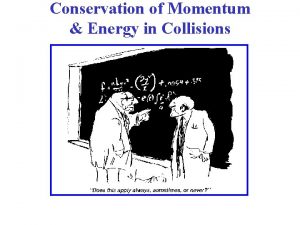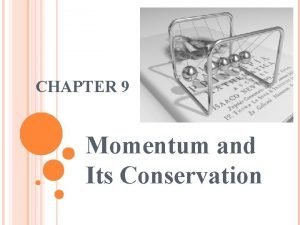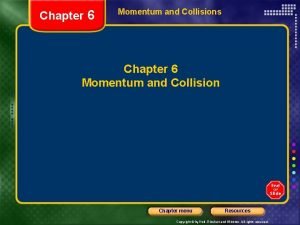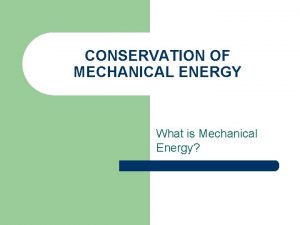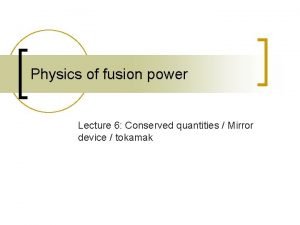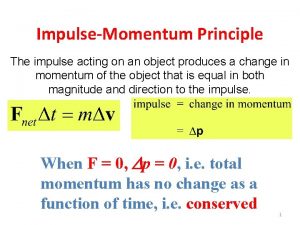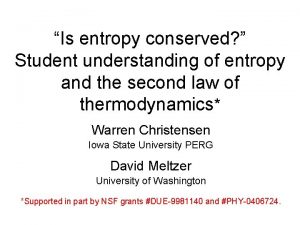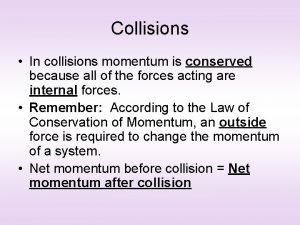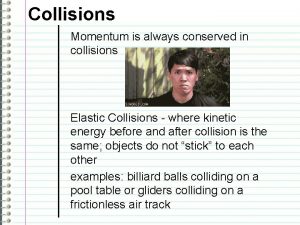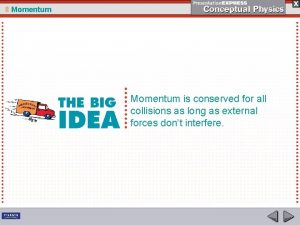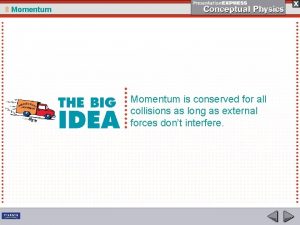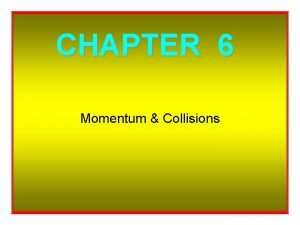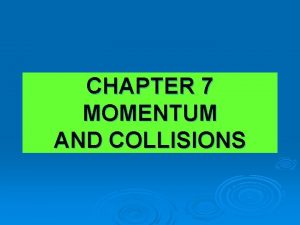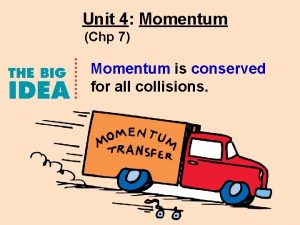Momentum is conserved for all collisions as long



















- Slides: 19

Momentum is conserved for all collisions as long as external forces don’t interfere.

LAW OF CONSERVATION OF MOMENTUM • In the absence of outside influences, the total amount of momentum in a system is conserved. • The momentum of the cue ball is transferred to other pool balls. • The momentum of the pool ball (or balls) after the collision must be equal to the momentum of the cue ball before the collision • p before = p after

8. 4 Conservation of Momentum When any quantity in physics does not change, we say it is conserved. Conservation implies transfer without loss.

8. 5 Law of Conservation and Collisions Motion of the cue ball Motion of the other balls Whenever objects collide in the absence of external forces, the net momentum of the objects before the collision equals the net momentum of the objects after the collision.

Figure 8. 10 Momentum of cannon and cannonball

8. 4 Conservation of Momentum The momentum before firing is zero. After firing, the net momentum is still zero because the momentum of the cannon is equal and opposite to the momentum of the cannonball. Velocity cannon to left is negative Velocity of cannonball to right is positive (momentums cancel each other out!)

8. 5 Two Types of Collisions • Elastic Collision: When objects collide without sticking together • Inelastic Collision: When objects collide and deform or stick together.

8. 5 Inelastic Collisions Start with less mass, end up with more mass Notice how speed changes to conserve momentum (more mass, less speed—inverse relationship!)

Example of an elastic collision with objects same speed but different masses What happens to the speed of the smaller car after the elastic collision with the more massive truck? Notice that the car has a positive velocity and the truck a negative velocity. What is the total momentum in this system?

Example of an elastic collision with objects same speed but different masses What happens to the speed of the smaller car after the elastic collision with the more massive truck? (the car’s speed increases to conserve momentum) Notice that the car has a positive velocity and the truck a negative velocity. What is the total momentum in this system? (-40, 000 kg x m/s [20, 000 - 60, 000 kg x m/s)

Calculating conservation of momentum • Equation for elastic collisions m 1 v 1 + m 2 v 2 = m 1 v 1 + m 2 v 2 Before collision After collision • Equation for inelastic collision m 1 v 1 + m 2 v 2 = (m 1 + m 2)v 2 Before collision After collision


Changes in Velocity Conserve Momentum A. Elastic collisions with equal massed objects show no change in speed to conserve momentum • http: //www. walter-fendt. de/ph 14 e/ncradle. htm • http: //www. walter-fendt. de/ph 14 e/collision. htm B. Elastic collisions with inequally massed objects show changes in speed to conserve momentum – Larger mass collides with smaller mass—smaller mass object’s speed is greater than the larger mass object – Smaller mass object collides with larger mass object—larger mass object’s speed is much less than the smaller mass object – http: //www. walter-fendt. de/ph 14 e/collision. htm C. Addition of mass in inelastic collisions causes the speed of the combined masses to decrease in order for momentum to be conserved

8. 5 Examples of Elastic Collisions when the objects have identical masses a. A moving ball strikes a ball at rest. Note: purple vector arrow represents velocity: speed and direction

8. 5 Examples of Elastic Collisions when the objects have identical masses a. A moving ball strikes a ball at rest. Momentum of the first ball was transferred to the second; velocity is identical

8. 5 Examples of Elastic Collisions when the objects have identical masses b. Two moving balls collide head-on.

8. 5 Examples of Elastic Collisions when the objects have identical masses b. Two moving balls collide head-on. The momentum of each ball was transferred to the other; each kept same speed in opposite direction

8. 5 Examples of Elastic Collisions when the objects have identical masses c. Two balls moving in the same direction at different speeds collide.

8. 5 Examples of Elastic Collisions when the objects have identical masses c. Two balls moving in the same direction at different speeds collide. The momentum of the first was transferred to the second and the momentum of the second was transferred to the first. Speeds to conserve momentum.
 Is momentum conserved in all collisions
Is momentum conserved in all collisions Momentum is conserved
Momentum is conserved Perfectly inelastic collision
Perfectly inelastic collision Conservation of momentum definition
Conservation of momentum definition Momentum and its conservation chapter 9
Momentum and its conservation chapter 9 Conservation of linear momentum
Conservation of linear momentum Momentum and collisions
Momentum and collisions A roller coaster climbs up a hill at 4m/s and then
A roller coaster climbs up a hill at 4m/s and then Elastic collisions
Elastic collisions Chapter 6 momentum
Chapter 6 momentum Long and short
Long and short Long long long ago there lived a little girl
Long long long ago there lived a little girl Conservation of mechanical energy
Conservation of mechanical energy Mechanical energy examples
Mechanical energy examples Conservation of mechanical energy
Conservation of mechanical energy Magnetic field drift
Magnetic field drift Principle of impulse
Principle of impulse Kinetic energy gravitational
Kinetic energy gravitational Is entropy conserved
Is entropy conserved Chapter 6 momentum changing momentum
Chapter 6 momentum changing momentum


